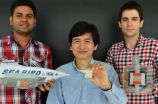(Press-News.org) There is growing scientific concern that corals could retreat from equatorial seas and oceans as the Earth continues to warm, a team of international marine researchers warned today.
Working on clues in the fossil coral record from the last major episode of global warming, the period between the last two ice ages about 125,000 years ago, the researchers found evidence of a sharp decline in coral diversity near the equator.
"When the climate warmed rapidly during the Last Interglacial, coral species diversity was much lower close to the Equator than at higher latitudes," says Professor John Pandolfi of CoECRS and The University of Queensland.
"It appears that during this period the number of coral species present in equatorial oceans was only 50-60% of the diversity found further away from the equator, and diversity was greatest in the northern hemisphere."
Professor Pandolfi and his German colleagues found that, when sea surface temperatures warmed by about 0.7 of a degree Celsius during the interglacial warm period, it was enough to drive many species of coral out of equatorial waters up to 10 degrees of latitude on either side of the equator.
"Our results suggest that the poleward range expansions of reef corals occurring with intensified global warming today may soon be followed by equatorial range retractions," the team says in their latest paper, published in the Proceedings of the US National Academy of Sciences.
"Earlier work revealed that the corals had marched as far south as Margaret River in Western Australia during the interglacial – and we wanted to establish what was happening at the 'hot end' of the corals' range," Prof. Pandolfi explains.
"The answer is, increased temperatures resulted in the extirpation of many coral species in equatorial waters, leading to much poorer reef systems."
What concerns the scientists is that the planet has already warmed by 0.7 of a degree since the start of the industrial age – a similar amount to the last interglacial – and while the corals have not yet abandoned equatorial waters, modern equatorial diversity is lower compared to adjacent latitudes north and south.
"If this is the case, it has serious implications for the nations of the Coral Triangle, such as Indonesia and the Philippines, where tens of millions of people rely upon the oceans for their livelihoods and food.
"The picture that is forming is one of corals moving back and forth, towards the poles during warm periods, and retracting towards the equator in cooler times, in search of the most favourable water conditions.
"It is going to be important to factor this kind of dynamism into how we manage them in the hot times which we now know lie ahead."
Prof. Pandolfi has devoted many years to studying major fossilised coral reef deposits around the world most of which are now on dry land – but which grew in the ocean during warmer periods when sea levels were much higher than today.
"Many of these reefs lie 4-6 metres above today's high tide mark, and are a clear indicator of how much the oceans rose during the last interglacial.
"The thought that just 0.7 of a degree of sea surface warming back then caused a 4-6 metre ocean rise is distinctly disturbing – because that is how much the Earth has already heated in the current warming episode, and the predictions are for a further one degree or more by 2050.
"Corals, we know, have responded quite readily to rising sea levels in the absence of human stressors. The question will be: can humans respond equally well?"
###
The paper "Equatorial decline of reef corals during the last Pleistocene interglacial" by Wolfgang Kiessling, Carl Simpson, Brian Beck, Heike Mewis and John M. Pandolfi appears in the latest issue of the journal Proceedings of the US National Academy of Sciences (PNAS).
More information:
Professor John Pandolfi, CoECRS and UQ, +61 (0)7 3365 3050 or +61 400 982 301
Jenny Lappin, CoECRS, +61 (0)7 4781 4222
Jan King, UQ Communications Manager, +61 (0)7 3365 1120
http://www.coralcoe.org.au/
Scary news for corals -- from the Ice Age
2012-12-12
ELSE PRESS RELEASES FROM THIS DATE:
Keck School of Medicine of USC researchers find clue to how Hepatitis C virus harms liver
2012-12-12
Researchers at the University of Southern California (USC) have discovered a trigger by which the Hepatitis C virus enters liver cells ─ shedding light on how this serious and potentially deadly virus can begin to damage the liver.
The findings, reported in the Dec. 7, 2012 issue of the Journal of Biological Chemistry, may give scientists a target for future development of treatments for the virus.
In the early stages of a Hepatitis C Virus (HCV) infection, the researchers found, the virus binds to receptors on the liver cells' surface and activates PI3K and ...
Home visiting program for first-time moms may be struggling to reduce serious injuries to children
2012-12-12
New research from PolicyLab at The Children's Hospital of Philadelphia shows that one of the nation's largest programs providing home visitation support for at-risk mothers and children may not be as successful in reducing early childhood injuries as it was in earlier evaluations. The researchers evaluated the Nurse-Family Partnership (NFP) over seven years of widespread implementation in Pennsylvania and found that children served by the program had no fewer injuries than children in comparable families not enrolled in the program—and in some less serious cases, had higher ...
Discovery in Ghent could improve screening for sudden cardiac death
2012-12-12
ARVC is a hereditary heart condition in which the heart muscle (particularly the right ventricle) is partly replaced by fatty tissue and connective tissue. Cardiac arrhythmias can occur as a result of the changes in the heart muscle. Severe arrhythmias can cause dizziness or even lead to fainting or an acute cardiac arrest (= sudden death). ARVC is a progressive disease that usually presents during the teenage years.
Known mutations in desmosomal proteins
Mutations in various genes have already been linked to ARVC. These are primarily genes that are responsible for the ...
Economists calculate true value of 'who' you know, rather than 'what' in US politics
2012-12-12
Economists at the University of Warwick have calculated the true value of US political lobbyists, proving the old adage 'it is not what you know, but who you know'.
In a paper published this month in the American Economic Review Mirko Draca, from the University of Warwick's Department of Economics, looked at the role of lobbyists in the US. He found their revenue falls by 24% when their former employer leaves government office.
The study examined the so-called 'revolving door' of politics, which refers to the movement of people from government service into lobbying positions.
Mr ...
NTU's 'sense-ational' invention helps underwater vessels navigate with ease
2012-12-12
Nanyang Technological University (NTU) scientists have invented a 'sense-ational' device, similar to a string of 'feelers' found on the bodies of the Blind Cave Fish, which enables the fish to sense their surrounding and so navigate easily.
Using a combination of water pressure and computer vision technology, the sensory device is able to give users a 3-D image of nearby objects and map its surroundings. The possible applications of this fish-inspired sensor are enormous. The sensor can potentially replace the expensive 'eyes and ears' on Autonomous Underwater Vehicles ...
Tsunami caused long-term ecosystem change in the Caribbean
2012-12-12
A detailed analysis of sediments from the island of Bonaire in the Caribbean presents convincing evidence for an extraordinary wave impact dating back some 3,300 years, even though no historical records of tsunamis exist for this island. Of particular interest are the consequences this large wave impact had on the island's ecosystem. The sediments studied by the scientists suggested that this tsunami entirely changed the coastal ecosystem and sedimentation patterns in the area. The work by Dr. Max Engel and colleagues, from the University of Köln in Germany, is published ...
Advance in chromosomal evolution in sea cradles
2012-12-12
The study of chromosome changes arisen during species evolution is a current and intriguing topic that evolutionary biology proposes. However, in several groups (for example, molluscs), and chitons in particular, chromosome studies are scarce, with a few species investigated and analyses performed mostly with simple methods.
Only 2,5% of about 900 living species of chitons have been so far karyologically investigated, all of them in the same order (Chitonida). The authors note that the species of suborder Chitonina all have a karyotype of 2n=24 chromosomes, all biarmed, ...
'Smart stethoscope' advance in monitoring treatment of kidney stones
2012-12-12
A new listening device, developed by scientists from the University of Southampton, is being used to monitor the effectiveness of the treatment of kidney stones - saving patients unnecessary repeat therapy and x-ray monitoring.
If kidney stones cannot be dissolved by drugs, the favoured procedure is lithotripsy. Lithotripsy works by focusing thousands of shock waves onto the kidney stones in an effort to break them into pieces small enough to urinate out of the body or be dissolved by drugs.
However, it is difficult to discover exactly when the treatment has succeeded ...
Rice, Texas Children's team creates biocompatible patch to heal infants with birth defects
2012-12-12
A painstaking effort to create a biocompatible patch to heal infant hearts is paying off at Rice University and Texas Children's Hospital.
The proof is in a petri dish in Jeffrey Jacot's lab, where a small slab of gelatinous material beats with the rhythm of a living heart.
Jacot, lead author Seokwon Pok, a postdoctoral researcher at Rice, and their tissue-engineering colleagues have published the results ofyears of effort to produce a material called a bioscaffold that could be sutured into the hearts of infants suffering from birth defects. The scaffold, seeded with ...
Climate modelers see possible warmer, wetter Northeast winters by 2070
2012-12-12
AMHERST, Mass. – A new high-resolution climate study by University of Massachusetts Amherst climate scientists, the first to apply regional climate models to examine likely near-term changes in temperature and precipitation across the Northeast United States, suggests temperatures are going to be significantly warmer in all seasons in the next 30 years, especially in winter. Also, they project that winters will be wetter, with more rain likely than snow.
Writing in the current issue of the Journal of Geophysical Research, Michael Rawlins and Raymond Bradley of the Climate ...


